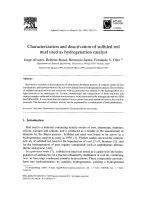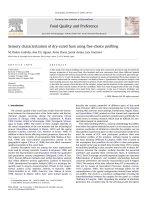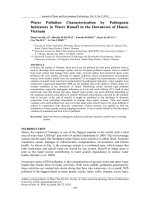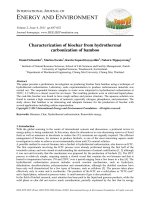03Catalyst Characterization
Bạn đang xem bản rút gọn của tài liệu. Xem và tải ngay bản đầy đủ của tài liệu tại đây (946 KB, 39 trang )
<span class='text_page_counter'>(1)</span>Catalyst Characterization 朱信 Hsin Chu Professor Dept. of Environmental Eng. National Cheng Kung University 1.
<span class='text_page_counter'>(2)</span> 1. Introduction . . . Physical properties: pore size, surface area, and morphology of the carrier; and the geometry and strength of the support Chemical properties: composition, structure, and nature of the carrier and the active catalytic components Changes during the catalysis process: deactivation 2.
<span class='text_page_counter'>(3)</span> 2. Physical Properties of Catalysts 2.1 Surface Area and Pore Size of the Carrier . . Surface area Pore size Pore size distribution Pore structure Pore volume The size and number of pores determine the internal surf ace area. It is usually advantageous to have high surface area (large number of small pores) to maximize the dispe rsion of catalytic components. However, if the pore size is too small, diffusional resista nce becomes a problem. 3.
<span class='text_page_counter'>(4)</span> 2.2 surface Area and Pore Size Measurements . . . A standardized procedure for determining the internal surface area of a porous material with surface area greater than 1 or 2 m2/g is based on the adsorption of N2 at liquid N2 temperature onto the internal surfaces of the carrier. Each adsorbed N2 molecule occupies an area of the surface co mparable to its cross-sectional area (16.2Å2) By measuring the number of N2 molecules adsorbed at monola yer coverage, one can calculate the internal surface area. Next slide (Fig. 3.1a) BET gas adsorptin plot Flatten part: monolayer Second rise: multiple layers 4.
<span class='text_page_counter'>(5)</span>
<span class='text_page_counter'>(6)</span> . The Brunaure, Emmett, and Teller (BET) equation describes the r elationship between N2 volume adsorbed at a given partial pressur e and the volume adsorbed at monolayer coverage: P 1 (C 1) P V ( P0 P ) VmC VmCP0. . where P = partial pressure of N2 P0 = saturation pressure at the experimental temperature V = volume adsorbed at P Vm= volume adsorbed at monolayer coverage C = a constant Next slide (Fig. 3.1b) Linear form of the BET equation The most reliable results are obtained at relative pressure (P/P 0) between 0.05 and 0.3. 6.
<span class='text_page_counter'>(7)</span>
<span class='text_page_counter'>(8)</span> . . The same equipment can be used to determine the pore si ze distribution of porous materials with diameters less th an 100Å, except that high relative pressures are used for condensing N2 in the catalyst pores. Next slide (Fig. 3.1c) Pore size distribution measurement The procedure involves measuring the volume adsorbed i n either the ascending or descending branch of the BET p lot at relative pressures close to 1. This plot shows the carrier having a significant volume o f mesopores (diameters between 20 and 500Å) 8.
<span class='text_page_counter'>(9)</span>
<span class='text_page_counter'>(10)</span> . Capillary condensation occurs in the pores in accordance with the Kelvin equation: ln(. P 2 V cos ) P0 rRT. where. . σ = surface tension of liquid nitrogen θ = contact angle V = molar volume of liquid nitrogen r = radius of the pore R = gas constant T = absolute temperature P = measured pressure P0 = saturation pressure The form of the Kelvin equation describes the desorption isotherm, and it is the preferred one for calculation of pore size distribution. (desorption requires a lower pressure compared to adsorption) 10.
<span class='text_page_counter'>(11)</span> 2.3 Pore Size by Mercury Intrusion . . For materials with pore diameters greater than about 30Å, the me cury intrusion method is preferred. The penetration of mercury into the pores of a material is a funct ion of applied pressure. The Washburn equation:d 4 cos P. . where d = pore diameter, nm p = applied pressure, atm θ= wetting or contact angle, between the mercury and th e solid is usually 130o γ= the surface tension of the mercury, 0.48 N/m Next slide (Fig. 3.2) The mercury intrusion method: 30Å-10 6Å the BET method: < 100Å 11.
<span class='text_page_counter'>(12)</span>
<span class='text_page_counter'>(13)</span> 2.4 Particle Size Distribution of the Carrier . . . Sieves of various mesh sizes Reliable only for particles larger than about 40μm (#400 =38 μm) Light scattering, image analysis, sedimentation, centrifug ation, and volume exclusion (coulter counter) Reliable for finer particles Laser techniques (more recently) Next slide (Fig. 3.3) Laser-generated particle size distribution for an Al2O3 car rier F: fraction U: cumulation 13.
<span class='text_page_counter'>(14)</span>
<span class='text_page_counter'>(15)</span> 2.5 Washcoat Thickness. Optical microscopy is the most commonly used method of obtaining washcoat thickness.. 2.6 Mechanical Strength of a Monolith . . Monoliths, particularly when used in a stacked mode (e.g., in station ary pollution abatement) must resist crushing axially. For automobile and truck application, and for ozone abatement in air craft, resistance to vibration and radial strength is important.. 2.7 Adhesion. Erosion Thermal shocks (start up and shutdown) 15.
<span class='text_page_counter'>(16)</span> 2.8 Location and Analysis of Species within the Catalyst Scanning electron microscope (SEM) is equipped with a n energy dispersive analyzer (EDX) or wavelength disper sive analyzer (WDS). The bombardment of a sample with electrons generates X rays characteristic of the elements present. Next slides (Fig. 3.4 a ~ Fig. 3.4 d) WDS analysis for catalysts deposited on double-layered washcoats (a)(b): topcoat Pt dispersed on bottom coat SiO2 (c)(d): topcoat Pd dispersed on bottom coat Al2O3 16.
<span class='text_page_counter'>(17)</span>
<span class='text_page_counter'>(18)</span>
<span class='text_page_counter'>(19)</span>
<span class='text_page_counter'>(20)</span>
<span class='text_page_counter'>(21)</span> . Next slide (Fig. 3.5) A electron microscope line profile of a poisoned automobile exhaust catalyst P and Zn, originating from the lubricating oil, are concentrated on the edge of the washcoat indicati ng they physically deposited as aerosols. Gaseous sulfur compounds such as SO2/SO3, pen etrate deeply and more uniformly into the washcoat. 21.
<span class='text_page_counter'>(22)</span>
<span class='text_page_counter'>(23)</span> 3. Chemical Properties 3.1 Elemental Analysis . . . Small amounts of promoter oxides intentionally added (of ten < 0.1 %) can influence catalyst activity, selectivity, an d life. Carriers are derived from raw materials, which contain va rious impurities such as alkali and alkaline-earth compou nds, if used in excess, causing sintering or loss of surface area in Al2O3. When added in the proper amount, the sam e impurities can enhance stability against sinterting or, in some cases, improve selectivity. Therefore, the quantitative procedures used to analyze the composition of catalysts are important.. 23.
<span class='text_page_counter'>(24)</span> 3.2 Thermal Gravimetric Analysis (TGA) . . . TGA: a useful technique to follow microscopic weight change s A few milligrams of contaminated catalyst can be loaded into a quartz pan suspended in the microbalance. A controlled gas f low and temperature ramp is initiated and a profile of weight c hange versus temperature is recorded. Frequently, TGA units are equipped with a mass spectrometer so that the offgases from the catalyst can be measured as a fun ction of temperature. The weight-temperature profile is helpful in establishing proce dures for regenerating the catalyst and other processes in the p rocess reactor. 24.
<span class='text_page_counter'>(25)</span> 3.3 Analysis by X-Ray Diffraction (XRD) . . Provided a material is sufficiently crystalline to diffract X rays and is present in an amount greater than 1%, XRD can be used for qualitative and quantitative analysis. The angles of diffraction differ for the various planes within the crystal. Thus, every compound or element has its own somewhat unique diffraction pattern.. 3.4 Structural Analysis: structure of Al2O3 carriers . Next slide (Fig. 3.6) XRD patterns of amorphous γ-Al2O3 and α-Al2O3 25.
<span class='text_page_counter'>(26)</span>
<span class='text_page_counter'>(27)</span> . . γ-Al2O3: the high-surface-area, lower temperature structure α-Al2O3: produced at high temperature and has low surface area Amorphous: Materials with crystallites smaller than 50Å. A well-defined X-ray pattern will not be obtained. Need to be characterized by other techniques listed below. 27.
<span class='text_page_counter'>(28)</span> 3.5 Dispersion or Crystallite Size of Catalytic Species 3.5.1 Chemisorption . . . When a structure has a definite XRD pattern, it usually has less than optimum activity. This is because most catalytic reactions are favored by either amorphous materials or extremely small c rystallites. Frequently, the purpose of the preparation technique is to dispe rse the catalytic components to maximize their availability to r eactants: no. of catalytic sites on the surface 100% % dispersion = theoretical no. of sites present When this is done effectively, only small crystals are present a nd the diffraction of X rays is minimized. Selective chemisorption can be used to measure the accessible catalytic component on the surface by noting the amount of gas adsorbed per unit weight of catalyst. 28.
<span class='text_page_counter'>(29)</span> . . One assumes that the catalytic surface area is proportional to t he number of active sites. A gas that will selectively chemisor b only onto the metal and not the support is used under predet ermined conditions. Hydrogen and CO are most commonly used as selective adsor bates for many supported metals. The measurements are usually carried out in a static vacuum s ystem similar to that used for BET surface area measurements. Next slide (Fig. 3.7a) Chemisorption isotherm (monolayer coverage, 1 H per metal s ite) One can determine the catalytic surface area by multiplying m olecules adsorbed by cross-sectional area of the site and dividi ng by the weight of catalyst, e.g., the cross-sectional area of Pt is 8.9Å2 and Ni, 6.5Å2. 29.
<span class='text_page_counter'>(30)</span>
<span class='text_page_counter'>(31)</span> . . The static vacuum technique is time-consuming. Alternat ively, a dynamic pulse technique has been used in which a pulse of adsorbate such as H2 or CO is injected into a st ream of inert gas and passed through a bed of catalyst. Next slide (Fig. 3.7b) Pulse chemisporption profiles The static method measures only species that are strongl y adsorbed. The dynamic method, performed under equilibrium cond itions, measures strong and weakly chemisorbed species. Thus, static techniques usually give better dispersion res ults. 31.
<span class='text_page_counter'>(32)</span>
<span class='text_page_counter'>(33)</span> 3.5.2 Transmission Electronmicroscopy (TEM) . . . . A thin sample is subjected to a beam of electrons. The dar k spots on the positive of the detecting film correspond to dense areas in the sample that inhibit electron transmissio n. These dark spots form the outline of metal particles or cry stallites and, hence, their sizes can be determined. Next slide (Fig. 3.8) A TEM of sintered Pt, dispersed on TiO2 (500Å) Following slide (Fig. 3.9) Crystallites of Pt about 100Å in size, dispersed on CeO2 33.
<span class='text_page_counter'>(34)</span>
<span class='text_page_counter'>(35)</span>
<span class='text_page_counter'>(36)</span> 3.5.3 X-Ray Diffraction . . The larger the crystals of a given component, the sharper the peaks on the X RD pattern for each crystal plane. The scherrer equation: B. . k L cos . Where B = the breadth at half-peak height of an XRD line L = the size of the crystallites λ = X-ray wavelength θ = diffraction angle k = a constant usually equal to 1 As the crystallite size increases, the line breadth B decreases. Next slide (Fig. 3.10) XRD profile for different crystallite sizes of CeO2 36.
<span class='text_page_counter'>(37)</span>
<span class='text_page_counter'>(38)</span> 3.6 Surface Composition of Catalysts . . . XRD and TEM measure the structure and/or chemical co mposition of catalysts extending below the catalytic surfa ce. The composition of the surface is usually different from t hat of the bulk. It is on these surfaces that the active sites exist and where chemisorption, chemical reaction, and desorption take pl ace. The tools available for surface composition characterizati on are X-ray photoelectron spectroscopy (XPS), Auger el ectron spectroscopy (AES), ion scattering spectroscopy (ISS), and secondary-ion mass spectroscopy (SIMS). 38.
<span class='text_page_counter'>(39)</span> . . . XPS is used more widely than the others for studing the surface c omposition and oxidation states of industrial catalysts. XPS refers to the technique of bombarding the surface with X-ra y photons to produce the emission of characteristic electrons. These are measured as a function of electron energy. Because of the low energy of the characteristic electrons, the dept h to which the analysis is made is only ~40Å . The composition of this thin layer as a function of depth can be d etermined by removing or sputtering away top layers and analyzi ng the underlying surfaces. This technique can provide properties including oxidation state o f the active species, interaction of a metal with an oxide carrier, a nd the nature of chemisorbed poisons and other impurities.. 39.
<span class='text_page_counter'>(40)</span>









